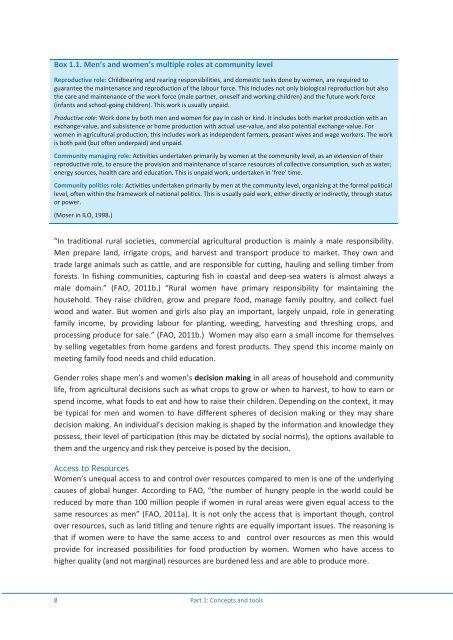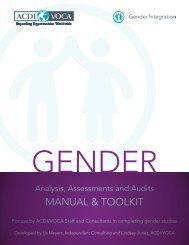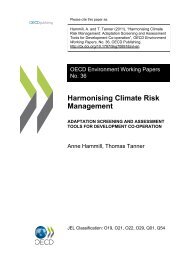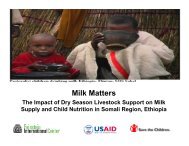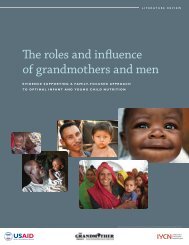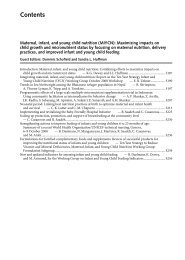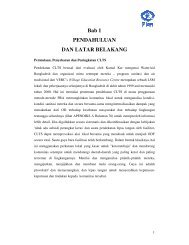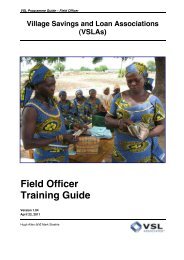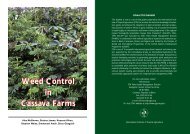Gender and climate change research in - FAO
Gender and climate change research in - FAO
Gender and climate change research in - FAO
You also want an ePaper? Increase the reach of your titles
YUMPU automatically turns print PDFs into web optimized ePapers that Google loves.
Box 1.1. Men’s <strong>and</strong> women’s multiple roles at community level<br />
Reproductive role: Childbear<strong>in</strong>g <strong>and</strong> rear<strong>in</strong>g responsibilities, <strong>and</strong> domestic tasks done by women, are required to<br />
guarantee the ma<strong>in</strong>tenance <strong>and</strong> reproduction of the labour force. This <strong>in</strong>cludes not only biological reproduction but also<br />
the care <strong>and</strong> ma<strong>in</strong>tenance of the work force (male partner, oneself <strong>and</strong> work<strong>in</strong>g children) <strong>and</strong> the future work force<br />
(<strong>in</strong>fants <strong>and</strong> school-go<strong>in</strong>g children). This work is usually unpaid.<br />
Productive role: Work done by both men <strong>and</strong> women for pay <strong>in</strong> cash or k<strong>in</strong>d. It <strong>in</strong>cludes both market production with an<br />
ex<strong>change</strong>-value, <strong>and</strong> subsistence or home production with actual use-value, <strong>and</strong> also potential ex<strong>change</strong>-value. For<br />
women <strong>in</strong> agricultural production, this <strong>in</strong>cludes work as <strong>in</strong>dependent farmers, peasant wives <strong>and</strong> wage workers. The work<br />
is both paid (but often underpaid) <strong>and</strong> unpaid.<br />
Community manag<strong>in</strong>g role: Activities undertaken primarily by women at the community level, as an extension of their<br />
reproductive role, to ensure the provision <strong>and</strong> ma<strong>in</strong>tenance of scarce resources of collective consumption, such as water,<br />
energy sources, health care <strong>and</strong> education. This is unpaid work, undertaken <strong>in</strong> 'free' time.<br />
Community politics role: Activities undertaken primarily by men at the community level, organiz<strong>in</strong>g at the formal political<br />
level, often with<strong>in</strong> the framework of national politics. This is usually paid work, either directly or <strong>in</strong>directly, through status<br />
or power.<br />
(Moser <strong>in</strong> ILO, 1998.)<br />
“In traditional rural societies, commercial agricultural production is ma<strong>in</strong>ly a male responsibility.<br />
Men prepare l<strong>and</strong>, irrigate crops, <strong>and</strong> harvest <strong>and</strong> transport produce to market. They own <strong>and</strong><br />
trade large animals such as cattle, <strong>and</strong> are responsible for cutt<strong>in</strong>g, haul<strong>in</strong>g <strong>and</strong> sell<strong>in</strong>g timber from<br />
forests. In fish<strong>in</strong>g communities, captur<strong>in</strong>g fish <strong>in</strong> coastal <strong>and</strong> deep-sea waters is almost always a<br />
male doma<strong>in</strong>.” (<strong>FAO</strong>, 2011b.) “Rural women have primary responsibility for ma<strong>in</strong>ta<strong>in</strong><strong>in</strong>g the<br />
household. They raise children, grow <strong>and</strong> prepare food, manage family poultry, <strong>and</strong> collect fuel<br />
wood <strong>and</strong> water. But women <strong>and</strong> girls also play an important, largely unpaid, role <strong>in</strong> generat<strong>in</strong>g<br />
family <strong>in</strong>come, by provid<strong>in</strong>g labour for plant<strong>in</strong>g, weed<strong>in</strong>g, harvest<strong>in</strong>g <strong>and</strong> thresh<strong>in</strong>g crops, <strong>and</strong><br />
process<strong>in</strong>g produce for sale.” (<strong>FAO</strong>, 2011b.) Women may also earn a small <strong>in</strong>come for themselves<br />
by sell<strong>in</strong>g vegetables from home gardens <strong>and</strong> forest products. They spend this <strong>in</strong>come ma<strong>in</strong>ly on<br />
meet<strong>in</strong>g family food needs <strong>and</strong> child education.<br />
<strong>Gender</strong> roles shape men’s <strong>and</strong> women’s decision mak<strong>in</strong>g <strong>in</strong> all areas of household <strong>and</strong> community<br />
life, from agricultural decisions such as what crops to grow or when to harvest, to how to earn or<br />
spend <strong>in</strong>come, what foods to eat <strong>and</strong> how to raise their children. Depend<strong>in</strong>g on the context, it may<br />
be typical for men <strong>and</strong> women to have different spheres of decision mak<strong>in</strong>g or they may share<br />
decision mak<strong>in</strong>g. An <strong>in</strong>dividual’s decision mak<strong>in</strong>g is shaped by the <strong>in</strong>formation <strong>and</strong> knowledge they<br />
possess, their level of participation (this may be dictated by social norms), the options available to<br />
them <strong>and</strong> the urgency <strong>and</strong> risk they perceive is posed by the decision.<br />
Access to Resources<br />
Women’s unequal access to <strong>and</strong> control over resources compared to men is one of the underly<strong>in</strong>g<br />
causes of global hunger. Accord<strong>in</strong>g to <strong>FAO</strong>, “the number of hungry people <strong>in</strong> the world could be<br />
reduced by more than 100 million people if women <strong>in</strong> rural areas were given equal access to the<br />
same resources as men” (<strong>FAO</strong>, 2011a). It is not only the access that is important though, control<br />
over resources, such as l<strong>and</strong> titl<strong>in</strong>g <strong>and</strong> tenure rights are equally important issues. The reason<strong>in</strong>g is<br />
that if women were to have the same access to <strong>and</strong> control over resources as men this would<br />
provide for <strong>in</strong>creased possibilities for food production by women. Women who have access to<br />
higher quality (<strong>and</strong> not marg<strong>in</strong>al) resources are burdened less <strong>and</strong> are able to produce more.<br />
8 Part 1: Concepts <strong>and</strong> tools


